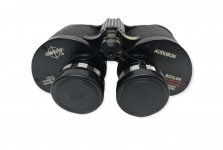scotchmist
Member

Hallo, am a new birder. Just want to thank all in this thread for helping me research and evaluate an advert for what seems to be a Swift Audubon 804 Mk 2 WA (1968-1970). I'm on a limited budget so looked to get best bang per buck, sacrificing weight/novel materials for price. These bins show sand in their rotary parts but are said to be 'working'. Wish me luck! I think first thing I need to do is to find a secure harness so the leatherette lanyard is not tested. I'll report back later whether I've paid £60 for trash.













